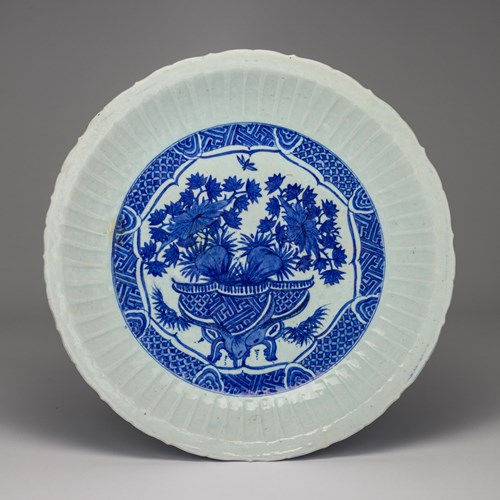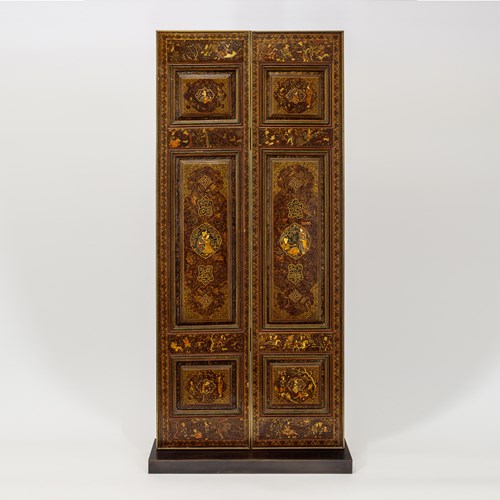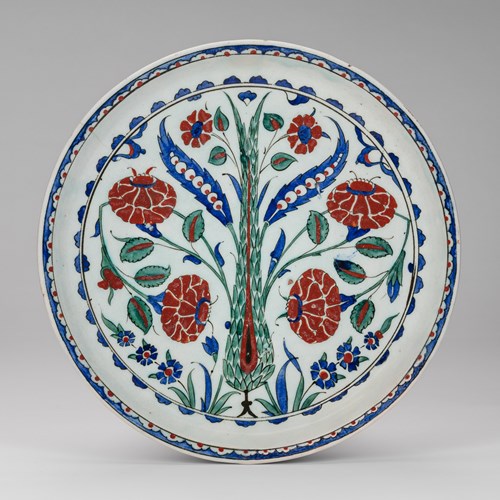Marketplace
Hispano-Moresque Lustre Charger with Rabbit Design
Hispano-Moresque Lustre Charger with Rabbit Design
Period 16t century
Origin Spain
Medium Glazed and lustre-painted earthenware
Dimension 39 cm (15³/₈ inches)
This shimmering large lustre charger is covered in creamy-white tin glaze and painted in blue and brown copper lustre. The brim and the well are divided by a thick concentric brown line with additional thin lines parallel to it, while the raised central part is painted entirely in brown. The well contains a pair of three-petal flowers and a pair of tent-shaped motifs, all outlined in blue. The rest of the well is filled with leaves and tendrils. The brim repeats the same flower and tent motifs with blue outline, but on a slightly larger scale. In the background are the same leaves and tendrils, with the addition of four rabbits running anti-clockwise. Using rabbit as a decorative element is uncommon in Hispano-Moresque objects, which makes this charger a unique example. The design on the reverse, painted all in brown copper-lustre, is typical of the sixteenth century; it is painted with a central rosette surrounded by concentric circles, the reverse of the brim has fern leaves and whorls.
The techniques of lustre and opaque white tin-glaze, both originated from the Middle East, were brought to the Iberian Peninsula in the 8th century during the Umayyad conquest. The lustre technique uses glaze that contains silver- and copper-salt, resulting in the shiny and metallic look in ceramics after firing. The opaque white tin-glaze imitates the white colour of Chinese porcelain, which was considered a luxurious commodity in the medieval period. Although Islamic characteristics can still be observed on pottery produced in al-Andalus in the 13th century, local potters have developed an extensive set of decorative vocabulary native to Spain by the 15th century. This includes not only animal and vegetal designs, but also shields of arms from prominent families for products that were custom made. Spanish lustreware reached its height between the 14th-16thcentury, evidenced by an explosive range of highly sophisticated designs. This charger is a very rare late example of lustreware in this region, as religious expulsion and Renaissance impacted later production to shift focus on Europeanised figural representations.
Comparative material:
Barberm Edwin Atlee, Hispano-Moresque Pottery in the Collection of the Hispanic Society of America. New York (State): The Hispanic Society of America, 1915. Plate L, Cat.71 and Plate LXVI, Cat.95.
Reference:
Anthony Ray, Spanish Pottery 1248-1898, with a Catalogue of the Collection in the Victoria and Albert Museum (London: V&A Publications, n.d.).
Stock No.: A5399
The techniques of lustre and opaque white tin-glaze, both originated from the Middle East, were brought to the Iberian Peninsula in the 8th century during the Umayyad conquest. The lustre technique uses glaze that contains silver- and copper-salt, resulting in the shiny and metallic look in ceramics after firing. The opaque white tin-glaze imitates the white colour of Chinese porcelain, which was considered a luxurious commodity in the medieval period. Although Islamic characteristics can still be observed on pottery produced in al-Andalus in the 13th century, local potters have developed an extensive set of decorative vocabulary native to Spain by the 15th century. This includes not only animal and vegetal designs, but also shields of arms from prominent families for products that were custom made. Spanish lustreware reached its height between the 14th-16thcentury, evidenced by an explosive range of highly sophisticated designs. This charger is a very rare late example of lustreware in this region, as religious expulsion and Renaissance impacted later production to shift focus on Europeanised figural representations.
Comparative material:
Barberm Edwin Atlee, Hispano-Moresque Pottery in the Collection of the Hispanic Society of America. New York (State): The Hispanic Society of America, 1915. Plate L, Cat.71 and Plate LXVI, Cat.95.
Reference:
Anthony Ray, Spanish Pottery 1248-1898, with a Catalogue of the Collection in the Victoria and Albert Museum (London: V&A Publications, n.d.).
Stock No.: A5399
Period: 16t century
Origin: Spain
Medium: Glazed and lustre-painted earthenware
Dimension: 39 cm (15³/₈ inches)
More artworks from the Gallery









